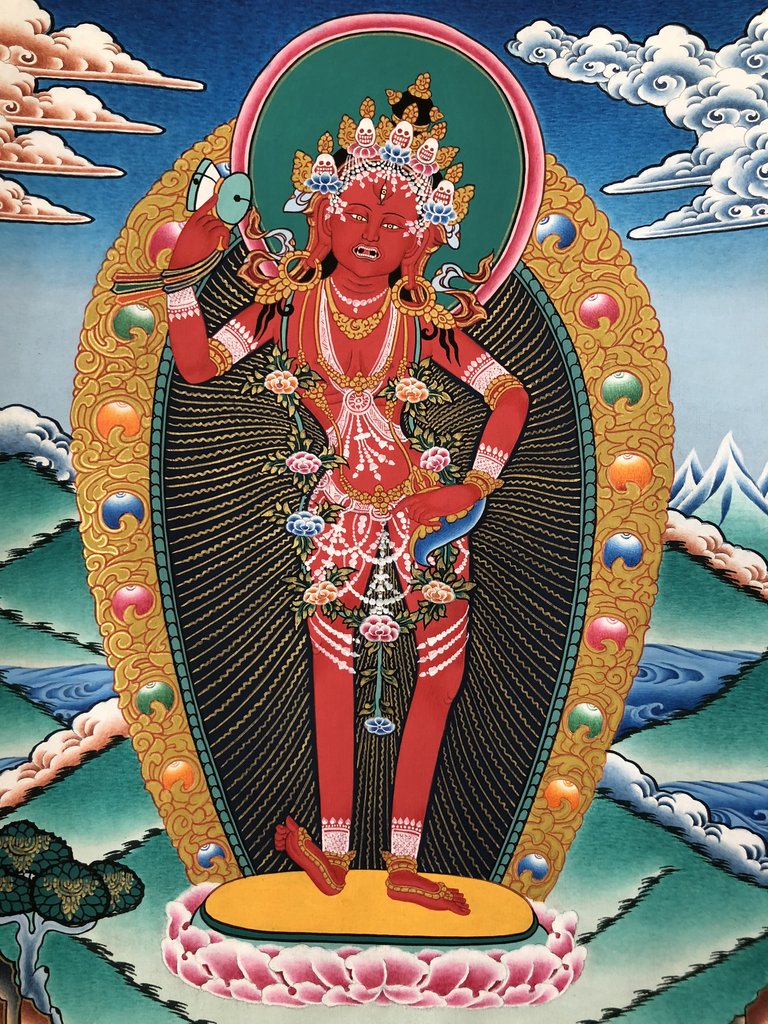Dechen Gyalmo (“The Queen of Great Bliss”) is a dakini and an emanation of the supreme Vajrayana goddess Vajrayogini (Tib. Dorje Naljorma). She is called Yumka (“Mother”) because of her role as a mother of all Buddhas and an incarnation of the Mahayana goddess Prajnaparamita.
Yumka Dechen Gyalmo originated from the Longchen Nyingthig Cycle, discovered by Jigme Lingpa (1730-1798), one of the most important figures in the Nyingma lineage of Tibetan Buddhism. In this cycle of teachings and practice, she is one of the three roots (tsa sum): lama – Rigdzin Düpa, yidam – Palchen Düpa, dakini – Yumka Dechen Gyalmo.
Yumka Dechen is depicted red in color, with a naked body. Her face is semi-wrathful and passionate. She holds a hand drum (damaru) in her right hand and a curved knife (drigug) in her left hand. Her body is in a standing pose with right foot raised, expressing her readiness to express her enlightened activities. Her distinctive feature is the long necklace of flowers, which adorns her body along with the traditional bone jewelry.
In the Tibetan Buddhist tradition, Yumka Dechen Gyalmo is regarded as the embodiment of the unity of wisdom that realizes emptiness and great bliss. Her dakini nature symbolizes the original purity and perfection, associated with the Buddha nature. His Holiness Penor Rinpoche (1932-2009), who was the 11th throne holder of the Palyul Lineage of the Nyingma school, reveals the essence of these qualities in relation to the purpose of Yumka’s practice: “The most important thing is to realize that everything is originally pure. In order to recognize the pure nature of all phenomena you need to change your perceptions. Perfect qualities are presented at all times in all beings. They must be awakened and manifested through the purification of the defilements of the mind and of the wrong perceptions”.*
Yumka’s practice aims to reveal the innate awareness (rigpa), which is beyond dualistic concepts. Its central deity is Yeshe Tsogyal, the 8th century Tibetan princess who was one of the main spiritual partners of Guru Padmasambhava. Her perfect qualities make her a supreme dakini, whose ultimate nature is associated with Samantabhadri (Kuntuzangmo), the female counterpart of the primordial Buddha Samanabhadra (Kuntuzangpo). Through this practice, the three bodies of the Buddha (ku sum) are recognized in a female form. Dharmakaya (cho ku) usually manifests as Samantabhadri, Sambhogakaya (long ku) as Vajravarahi and Nirmanakaya (trul ku) as Yeshe Tsogyal.

In some variations of the practice, Dharmakaya manifests as Vajravarahi, Sambhogakaya as Tara, and Nirmanakaya as Yeshe Tsogyal. In this case, the practitioner visualizes Yeshe Tsogyal with Green Tara in her heart and Vajravarahi in the heart of Tara. In this visualization, the three figures represent three aspects of one enlightened essence and hold the same attributes.
The unity of the three bodies of Buddha, manifested in feminine form, can also be found in the mantras of the female deities. The mantra of Yumka Dechen, OM PEMO YOGINI JNANA VARAHI HUNG and the mantra of Tara, OM TARE TUTTARE TURE SOHA, are combined into a common mantra, which is considered to be the essence of Yeshe Tsogyal. This sacred mantra is: OM PEMO YOGINI TARE TUTTARE TURE JNANA VARAHI SOHA.
* Instructions given by His Holiness Penor Rinpoche during Yumka Dechen Gyalmo empowerment in Trier, Germany in 2003.


